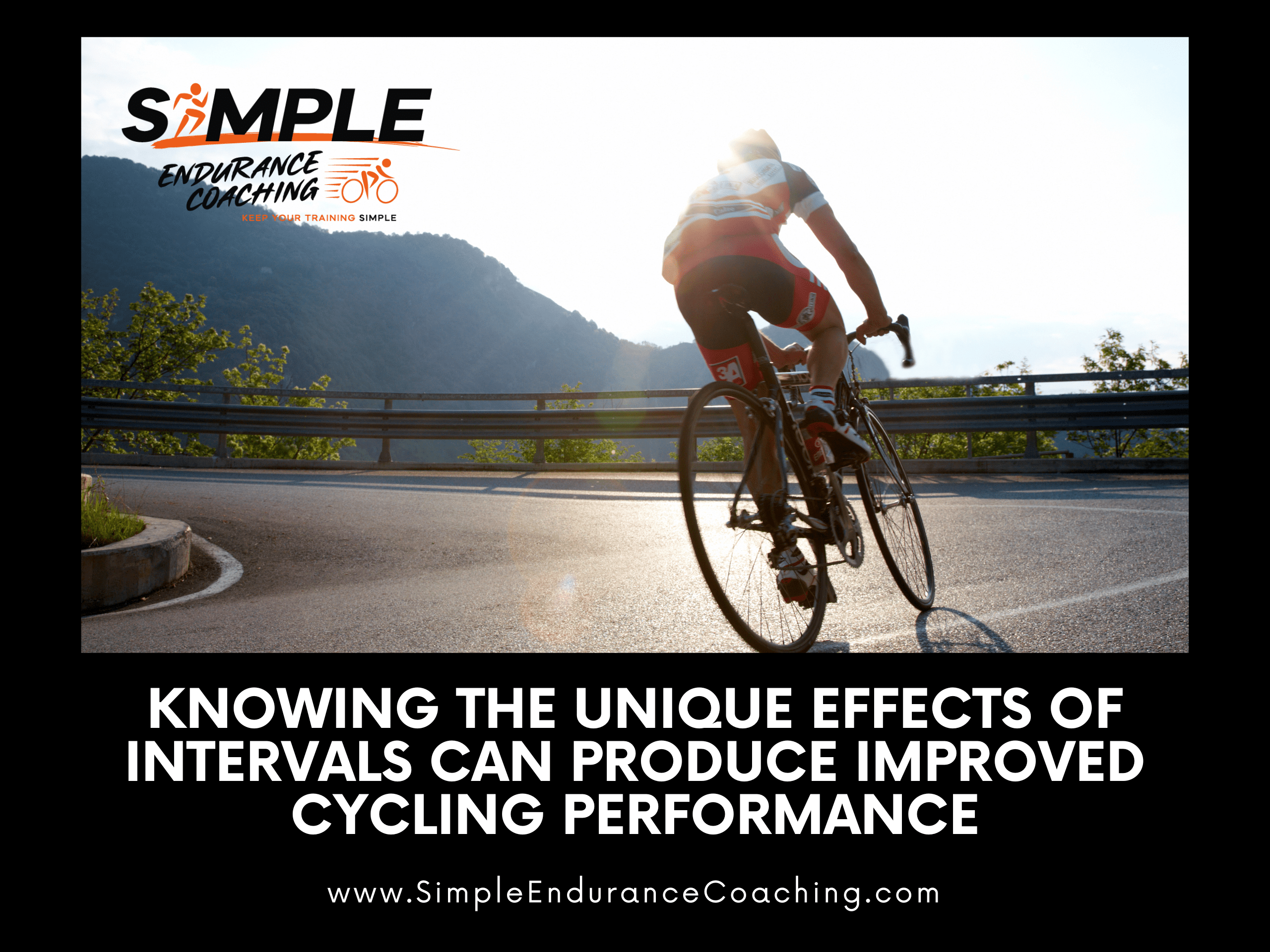Improve Cycling Performance: Unveiling the Effects of Intervals
Most types of cycling training will bring results.
Whether you’re doing endurance riding or VO2max intervals, you’re going to improve your fitness.
Understanding the differences between the types of training can help you tailor your training to your specific goals and needs.
Each type of interval targets different physiological systems and energy pathways and can help improve specific aspects of cycling performance.
But there’s a cost for each, and balancing your cycling training is critical to optimizing your performance.

Performance requires some intervals
Endurance training focuses on building your aerobic base and increasing your ability to ride for extended periods of time at a steady pace.
It is typically performed at a lower intensity than tempo or sweet spot training, and involves longer rides of several hours or more.
The goal of endurance training is to improve your endurance, develop your fat-burning ability, and improve your overall cycling economy.
This type of training primarily targets the aerobic energy system, which is used during long-duration exercise.
Research has shown that endurance training can increase mitochondrial density, enhance fat oxidation, and improve overall aerobic fitness (Bishop et al., 2010).
Tempo training can help build endurance to improve cycling performance
Tempo training is performed at a slightly higher intensity than endurance training, but still below your lactate threshold.
Tempo efforts are typically sustained for shorter periods of time, usually 20 to 40 minutes, with short rest periods in between.
The goal of tempo training is to increase your lactate threshold, improve your muscular endurance, and improve your ability to sustain a high pace for longer periods of time.
This type of training targets both the aerobic and anaerobic energy systems, and can help improve lactate threshold and muscular endurance.
Research has shown that tempo training can significantly improve time to exhaustion, lactate threshold, and VO2max (Laursen et al., 2005).
Sweet Spot training can be best of all worlds, but builds a lot of fatigue
Sweet spot training involves efforts performed at or just below your lactate threshold, typically in the range of 84-97% of your FTP (functional threshold power).
Sweet spot efforts can be longer than tempo efforts, typically lasting 30 to 60 minutes, and can be performed with shorter rest periods.
The goal of sweet spot training is to increase your lactate threshold, improve your overall endurance, and increase your ability to maintain high power output for longer periods of time.
This type of training targets both the aerobic and anaerobic energy systems, and can help improve muscular endurance and lactate threshold.
One advantage of sweet spot training is that it allows cyclists to achieve a high training stimulus with less recovery time compared to high-intensity interval training (HIIT) at higher intensities.
This can be especially beneficial for cyclists who have limited time for training or who are recovering from injury or illness.
Threshold training improves FTP and Time to Exhaustion
Threshold training involves riding at an intensity just above lactate threshold power or heart rate, typically around 95-105% of FTP.
This type of training primarily targets the anaerobic energy system, and can help improve maximal power output and lactate tolerance.
Research has shown that threshold training can improve both lactate threshold and VO2max (Seiler et al., 2013).
Threshold training focuses on increasing your lactate threshold, which is the point at which your body produces more lactate than it can clear, leading to fatigue and decreased performance.
By training at or just below your lactate threshold, you can increase your body’s ability to tolerate and clear lactate, leading to improved endurance and performance.
Threshold training has been shown to increase lactate threshold, power output at lactate threshold, and overall endurance.
A study published in the Journal of Strength and Conditioning Research found that eight weeks of threshold training significantly improved cycling performance in a group of trained cyclists, with improvements in lactate threshold, VO2 max, and time to exhaustion.
Threshold training is highly effective for improving your ability to sustain a high power output for longer periods of time, which is important for cyclists competing in time trials or long-distance events.
It can also be useful for cyclists looking to improve their overall fitness and endurance.
However, it’s important to note that threshold training can be highly intense and may lead to overtraining if not properly managed.
VO2max intervals can be really effective, but taxing
VO2max interval training involves riding at a very high intensity for short periods of time, typically around 120-150% of FTP.
VO2max intervals can help improve the body’s ability to deliver oxygen to working muscles during exercise.
VO2max training has been shown to increase an athlete’s maximal oxygen uptake.
In a study published in the Journal of Strength and Conditioning Research, researchers found that eight weeks of VO2max training significantly improved VO2max in competitive cyclists (Laursen et al., 2002).
VO2max training can also improve an athlete’s time to exhaustion at maximal effort.
A study in the International Journal of Sports Medicine found that four weeks of VO2max training improved cycling time to exhaustion at maximal effort in well-trained triathletes (Midgley et al., 2007).
VO2max training can also enhance an athlete’s aerobic power output.
In a study published in the European Journal of Applied Physiology, researchers found that six weeks of VO2max training improved the peak power output at VO2max by 5.5% in trained cyclists (Burgomaster et al., 2005).
Finally, VO2max training can also lead to increased recruitment of fast-twitch muscle fibers, which means you have more fibers available when you have to throw down the hammer.
A study published in the Medicine and Science in Sports and Exercise found that four weeks of VO2max training led to a shift from slow-twitch to fast-twitch muscle fiber recruitment during submaximal cycling exercise in trained cyclists (Gurd et al., 2010).
Blend threshold and sweet spot
Research suggests that incorporating both threshold and sweet spot training into a well-rounded training program can lead to significant improvements in cycling performance.
However, it’s important to note that the specific training program that is most effective will depend on an individual’s goals, fitness level, and cycling experience.
Carefully monitor your training stress
The issue in doing any kind of interval, from tempo to VO2max, is the training stress that accumulates.
While intervals work to create lots of adaptations, they are also tiring and cause fatigue.
That’s why the polarized approach of doing lots of endurance work, which builds some adaptations with little fatigue, and doing some interval work, which builds lots of adaptations with lots of fatigue, seems to work well.
Three things to know about intervals to improve cycling performance:
- Most of the cycling training we do creates enough training stress to produce adaptations.
- The harder the interval, the more fatigue it produces.
- A balance of most endurance training with some hard interval work seems to be the best mix.
Want to know more about what you can achieve?
If you liked this article, please share it with others.
Do you have questions? Email me at paulw at SimpleEnduranceCoaching.com
I support a limited number of cyclists and runners achieve their goals with more strength, endurance, and mobility.
Contact me or sign up for Virtual Coffee so we can discuss your goals, ask questions, and talk about making your endurance training more effective, fun, and Simple.
You can also opt-in to receive my weekly blog posts about what works in endurance sports.
Paul Warloski is a:
- USA Cycling Level 3 Coach
- RRCA Running Coach
- Training Peaks Level 2 Coach
- RYT-200 Yoga Instructor
- Certified Personal Trainer






2 Responses
Can you share the full citation for the Adnrews et al. 2015 article you’re referring to? Thanks!
Hi Josh, now I can’t find it either. I’d better remove it from the article. Thanks for checking.